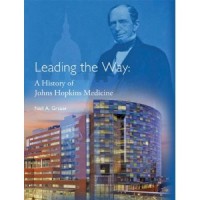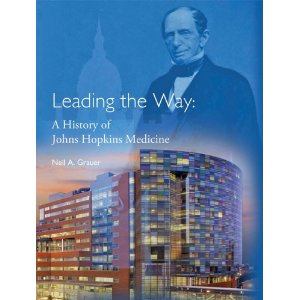 Author: Neil A. Grauer
Author: Neil A. Grauer
Publisher: Johns Hopkins University Press
Book Review by: Nano Khilnani
The Johns Hopkins Hospital, part of the vast Johns Hopkins Health System Corporation (read below) with its headquarters in Baltimore, Maryland, has been named the best hospital in the United States for an incredible 21 consecutive years by U.S. News and World Report. Its faculty has been garnering various kinds of awards and recognition for a long number of years, such as Nobel Prizes, National Medals of Science, Presidential Medals of Freedom and the Mac Arthur Foundation ‘genius’ awards.
The Johns Hopkins Health System includes: Johns Hopkins Hospital, All Children’s Hospital, Johns Hopkins Bayview Medical Center, Johns Hopkins Community Physicians, Inc., Johns Hopkins Employer Health Programs, Inc., Howard County General Hospital, Sibley Memorial Hospital and Suburban Hospital. Four other U.S. hospitals have recently joined the Johns Hopkins Medicine family: two in Maryland, one in Washington D.C. and one in Florida.
Affiliated with its system of hospitals is its family of several medical schools, collectively known as the Johns Hopkins Medical Institutions, comprising of: Johns Hopkins School of Medicine; Bloomberg School of Public Health, and Johns Hopkins School of Nursing, which are located on Hopkins’ East Baltimore medical campus.
To expand its influence overseas, the Johns Hopkins Medicine International has been recently added to its system of hospitals and medical schools.
Johns Hopkins is the world’s best-known healthcare institution, as one reads the jacket flap. Not having documented that from an independent source, I just as well agree with that, because it is not only one of the world’s oldest, having begun in 1889, but also one of largest families of institutions that I know of. Its physicians and researchers have likely garnered the largest number of awards in healthcare in general and medicine in particular.
The Johns Hopkins School of Medicine has an impressive 33 departments. Its multi-disciplinary institutes have advanced research and made new discoveries in numerous fields. Some of these areas are: biomedicine, cardiovascular care, cell engineering, genetic medicine, Lou Gehrig’s disease, and patient safety.
The Johns Hopkins family of hospitals and schools of medicine is 125 years old. It all began when Johns Hopkins, a wealthy merchant, businessman and banker bequeathed before his death in 1873 the then large sum of $7 million, which in today’s dollars is worth around $11 billion, writes Neil a Grauer, the biographer of Hopkins’ inspiring life and creator of this well-researched, highly informative and monumental study: a large, well-illustrated tome of 407 pages.
The $7 million that Johns Hopkins bequeathed – for the establishment of the two related entities – was seven times the combined amount in the coffers of two major universities: Princeton and Cornell.
This book’s publication coincided with the dedication in April 2012 of the billion-dollar, 1.6 million-square-foot Sheikh Zayed Cardiovascular and Critical Care Adult Tower and the Charlotte R. Bloomberg Children’s Center.
This book represents the most updated history of Johns Hopkins Medicine. The last one was written more than two decades ago. It is an impressive achievement of Grauer, a third-generation graduate of Johns Hopkins University, who has written about many aspects of this world-renowned institution in the past.
He is assistant director of editorial services in the marketing and communications office of Johns Hopkins Medicine. He is the author of seven other books, including two on humor – Wits & Sages; and Remember Laugher: A Life of James Thurber. He has also authored Centuries of Caring: The Johns Hopkins Bayview Medical Center Story.
This large tome is organized into six chapters in a chronology.
The first chapter covers the first fifty years of this healthcare institution, from its founding in 1889 until 1939. The next chapter details the next four decades from 1940 until 1988 as Johns Hopkins Medicine moved into the modern era.
The year 1989 marked the centenary of this organization. The third chapter covers the brief four-year period of 1989-1993 with the “changing of the guard.”
Turmoil and challenges confronted Johns Hopkins Medicine from 1994 to 1998. Those are the themes of the fourth chapter of this book.
The next four years – 1999 to 2003 – continued to be trying ones for this resilient institution. The fifth chapter is appropriately named Tested to the Limit: Surmounting Crises.
Many new developments marked the first decade of the new millennium – 2001 to 2011 – for Johns Hopkins. These are laid out and discussed in the last or sixth chapter of this book.
The story of Johns Hopkins begins with his birth on May 19, 1795. He was the second of what would become 11 children of Samuel and Hannah Janney Hopkins, who were well-to-do Quaker proprietors of a vast 500-acre tobacco plantation in the Anne Arundel County of Maryland. The Hopkins homestead, known as Whitehall, still stands today in Crofton, Maryland.
Johns Hopkins had a knack for numbers and what his mother told him at age 17 was prescient: “Thee has business ability, and thee must go where the money is.” Later in life, Johns Hopkins recalled that he “took kindly to merchandising.”
His ability with figures and his interest in merchandising led him to accumulating large sums of money, including initially, as an apprentice, helping his uncle Gerard increase his business to a considerable extent.
Uncle Gerard loaned Johns Hopkins around $10,000 to launch his own whiskey wholesaling enterprise. He established Hopkins Brothers, enlisting three of his brothers to sell whiskey in Maryland, Virginia and North Carolina. He had later told one of his cousins that in his first year in business, he had sold over $200,000 worth of goods.
His business grew fast and his money multiplied. After 25 years Johns Hopkins, who was then 50 years old in 1845, left his company a very wealthy man. He then used his substantial funds to go into banking, becoming Baltimore’s leading finance capitalist.
He later became president of Merchants National Bank of Baltimore and director of five other banks. By 1847, he became a substantial backer of the company known as Baltimore and Ohio Railroad and later, its largest shareholder. His wealth kept on growing and he became a philanthropist as well.
He had developed sufficient means to lead a comfortable life even before he turned 50 in 1845. For the next 28 years until his passing on Christmas Eve on December 24, 1873 he often thought of making a large contribution to humanity specifically by building a hospital and a medical school that would function together.
His hospital was built first, in 1889. Then followed his medical school about four years later 1in 1993. There were four ‘founding physicians’ and the author writes of them: “Their innovative methods, emulated by those who succeeded them, became the benchmark for hospitals and medical schools everywhere – both then and now.”
“From the teaching of medical students beside the patient’s bed, to the placement of diagnostic laboratories adjacent to clinics, to the emphasis on antiseptic surgery, Hopkins’ pioneering physicians set standards that remain hallmarks of Hopkins today.”
Johns Hopkins Medicine has indeed been leading the way in healthcare – in research, teaching and practice. Here are just some of the specific pioneering accomplishments of this venerable institution:
- Birth of cardiac surgery with the “Blue Baby operation
- Creation of cardiopulmonary resuscitation (CPR)
- Invention of electronic heart defibrillators
- Development of neuroscience and neurosurgery
- Fostering of the human genome project
- Making DNA breakthroughs that provided the foundation of stem cell research







